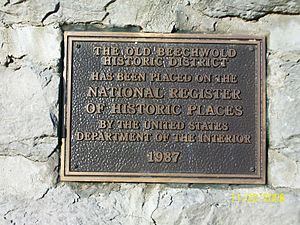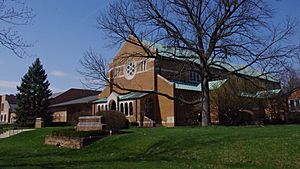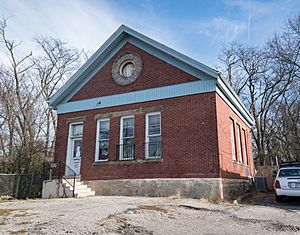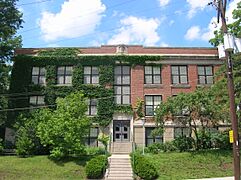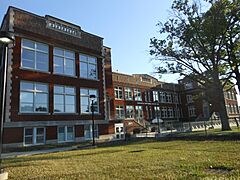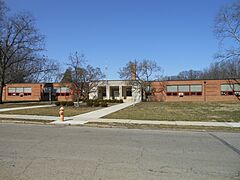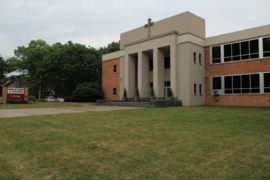Clintonville (Columbus, Ohio) facts for kids
Quick facts for kids
Clintonville
|
|
|---|---|
|
Neighborhood of Columbus
|
|
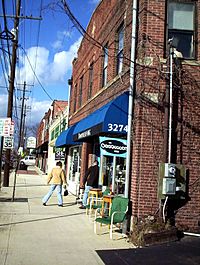
North High Street in Clintonville
|
|
| Country | United States |
| State | Ohio |
| County | Franklin |
| City | Columbus |
| ZIP Code |
43202, 43214
|
Clintonville is a cool suburban neighborhood in north-central Columbus, Ohio, United States. It's home to about 30,000 people! Its borders are the Olentangy River to the west, Glen Echo Creek to the south, some railroad tracks to the east, and the Worthington city limits to the north.
Over time, Clintonville became a very popular place to live. Because of this, homes north of Cooke Road started being called Clintonville or Beechwold. This made Beechwold and other nearby areas south of Worthington seem like part of Clintonville. The area also includes a former small town called Evanston. This name was used by the Big Four Railroad for a train station and by the U.S. Postal Service until the 1920s. Clintonville uses parts of ZIP codes 43202 and 43214. The main post offices for these ZIP codes are called Clintonville Station and Beechwold Station.
Contents
History of Clintonville
The community of Clintonville grew in Clinton Township. This area was named after George Clinton, who was a U.S. Vice President. The land here was given to Continental Army soldiers instead of pensions. This happened in what used to be Wyandot Native American territory.
For many years, the steep hills made it hard to build here. But then, the Bull family bought farmland and used it for church services. Clinton Chapel was built in 1838. This chapel later became a stop on the Underground Railroad, helping people escape slavery.
Thomas Bull, a Methodist minister, moved to Central Ohio in 1812 with his family. They came from Vermont. They first settled near Worthington while looking for land they could afford.
In 1813, Bull bought 600 acres of land from John Rathbone. This land was part of the United States Military Lands. These lands were set aside for soldiers who fought in the Revolutionary War. Rathbone, who owned the land, had never even visited Ohio!
Once the Bull family started farming, they faced a big problem: they were all alone. There was nowhere nearby to buy shoes or get things fixed. This made managing their large farm very difficult.
To get more people to move to the area, the Bulls built businesses in the center of Clinton Township. These businesses were along the main road that later became North High Street. This road connected Columbus to Worthington, Ohio. The Bulls offered to give these buildings to skilled workers who would stay. A post office called "Clintonville" opened there on September 13, 1847. Today, people in Clintonville celebrate this date as the neighborhood's "birthday."
By the early 1900s, people from downtown Columbus and professors from Ohio State University built summer homes in Clintonville. Soon after, the farmland became housing developments. This happened because the streetcar lines were extended north from Columbus. A business area also grew in Beechwold. It was separated from Clintonville by about a mile of homes. By the 1950s, both communities were fully part of Columbus. This happened when Columbus took over most of Clinton Township.
How Clintonville is Governed
Clintonville is part of the City of Columbus. This means the City of Columbus government runs it.
Columbus City Council members are elected by everyone in the city, not just from small areas. So, the city created "Area Commissions." These groups advise the city on things like building plans and changes to land use. The Clintonville and Beechwold neighborhoods are represented by the Clintonville Area Commission.
Nine people from the community are chosen to be commissioners. They are nominated through neighborhood elections. Then, the mayor of Columbus appoints them, and the City Council confirms them. There's also a special review process for the Old Beechwold area to keep its unique look.
Since 2004, some residents have wanted to be part of the Clintonville Area Commission. They live near Glen Echo Ravine. They feel their needs are more like Clintonville residents than those in the University Area. The city is now looking into how to handle such requests for all area commissions.
Neighborhoods in Clintonville
The land in Clintonville is split into two main areas. North High Street is the dividing line. The land west of North High Street, near the Olentangy River, is lower. The land east of North High Street is higher.
Six natural valleys, called glacial ravines, cut through the area. These are Glen Echo, Walhalla, Overbrook, Beechwold, Delawanda, and Bill Moose Run. Streams in these ravines flow into the Olentangy River. Four of these ravines have roads or homes built in them. Glen Echo was the first ravine saved as a public park in 1913. Part of Overbrook Ravine is now part of Whetstone Park, next to the Park of Roses.
Clintonville has five main residential areas:
- South Clintonville – South of North Broadway, this area has a mix of single and multi-family homes. Most of these houses were built before 1930. They show different styles, from basic American foursquare homes to other older designs. Many homes here were also "kit homes" bought from catalogs like Sears. These neighborhoods were planned for people who would use the High Street streetcar to get downtown. Garages for the oldest streets are found in alleys behind the houses.
- North Clintonville – This area is just north of North Broadway and goes up to the Overbrook Ravine. It shows how house styles and lifestyles changed from 1910 to the late 1950s. Homes here were built as fancier properties. They have driveways instead of alleys, showing that cars were becoming more important.
- Beechwold – This area is named after the Jeffrey family's summer home on North High Street. Beechwold has many different kinds of houses. You can find smaller Cape Cod style homes and also very fancy, expensive houses. These high-end homes are on the land where the Jeffrey family estate used to be. It's generally the area north of Henderson Road, south of Riverview Park, east to Indianola Avenue, and west to the Olentangy River.
- North of Morse – This area is north of Morse Road and goes up to the Worthington city limits. It's home to Bill Moose Run, the recently updated Graceland Shopping Center, the Ohio School for the Deaf, and the Ohio State School for the Blind. A new park was recently built where Sharon Elementary School used to be.
- Old Beechwold – Old Beechwold is the only neighborhood in Clintonville that is listed on the city, state, and National Historic Registry. This means it's a very important historical place! Old Beechwold is bordered by High Street to the east and the Olentangy River to the west. The northernmost street is W. Jeffrey Place, and the southernmost street is Riverview Park.
Streets of Clintonville
Many streets in Columbus neighborhoods are named after early settlers or places in Great Britain. But the streets in the Walhalla Park Place part of Clintonville are special. They were named by Mathias Armbruster, who came from Bavaria. He loved Norse mythology and Wagnerian operas. So, these streets have names like Druid, Mimring, Midgard, Brynhild, Gudrun, and Walhalla.
Here are some early settlers who have streets named after them:
- Judge Orland Aldrich (1882)
- Isaac Brevoort (1814)
- Reverend Philander Chase (1817) – He was the first Episcopal Bishop of Ohio.
- John Webster (1831)
- Jacob Weisheimer (1865)
- Dr. Charles Wetmore (1830)
Here are some early land owners who have streets named after them:
- Henry C. Cook(e)
- A. Henderson
- Thomas A. Ingham
- Walter Guy Richards
- L. E. Schreyer
Famous Places and Landmarks
Popular landmarks in Clintonville include its historic sites, the "Welcome to Clintonville" signs, and Immaculate Conception Church.
A historical marker for Clinton Township and Clintonville is now at the entrance to the Clintonville Woman's Club. It used to be a mile south, at the corner of East North Broadway and North High streets.
Here are some landmarks listed on the national and Columbus historic registers:
- A.B. Graham House
- East North Broadway Historic District
- Northmoor Engine House
- Old Beechwold Historic District
- Richard Berry Jr. House
- Truman and Sylvia Bull Coe House
- Weisheimer House
Whetstone Park: A Green Oasis
Whetstone Park in Clintonville is a famous Columbus landmark. The park has bike trails, baseball fields, tennis courts, a pond, a ravine, a library, and a recreation center. It also includes the 13-acre (5.3 ha) Columbus Park of Roses.
The Park of Roses opened in 1952. It's a popular spot for weddings and special events. Every June, the Park of Roses hosts its yearly "Rose Festival." During summer, many Columbus brass bands play concerts every Sunday evening at the park's gazebo. This gazebo used to be at Fort Hayes and was moved and fixed up in 1976.
Olentangy Park: A Blast from the Past
Clintonville was once home to the biggest amusement park in the United States! It first opened in 1880 as "The Villa." By 1900, this 100-acre (0.40 km2) park became Olentangy Park in 1896.
This park was located along North High Street between North Street and Tulane Road. It grew very quickly between 1900 and 1915. At one point, it had four large roller coasters, including a rare looping coaster called the "Loop the Loop". It also had a zoo, a dance hall, a big "Shoot-the-Chutes" water slide, and a building where visitors could rent canoes for the Olentangy River. It even had the largest theater and the largest swimming pool in the country at that time!
Olentangy Park closed after its last season in 1937. The land was sold in 1938. The Olentangy Village apartment complex was built there. You could still find small parts of the park in the woods by the river as late as the 1980s. The park's carousel was moved several times. In 1999, it was restored. You can now see this carousel at the Columbus Zoo and Aquarium.
Columbus Zoo: Its First Home
Columbus's very first zoo was located right here in Clintonville! It opened in May 1905 and was called the "Columbus Zoological Gardens." It was in what is now Old Beechwold, at Beechwold Road and North High Street.
Sadly, the zoo closed only five months later, in October 1905. The only buildings left from the zoo are its monkey house, which is now a barn at 150 W. Beechwold Blvd., the zoo's stone entrance, and the "kissing bridge," which is now Rustic Bridge Road.
Historic School Buildings




